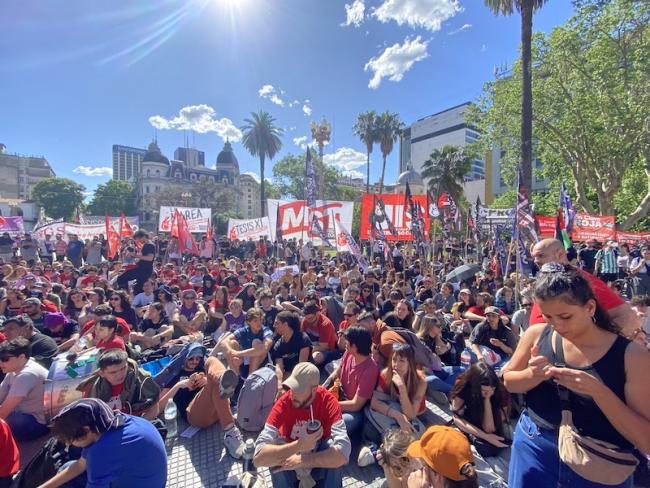by LUCAS BRICCA

Behind Argentina’s tide of university occupations, student groups spar over the movement’s trajectory.
As the morning sun shines through the windows of the University of Buenos Aires’ Faculty of Social Sciences (FSOC) on October 9, students sit up from makeshift cardboard mattresses. No lectures will be held in these classrooms; instead, they serve as the meeting rooms and sleeping quarters for students who are occupying the faculty in defense of public universities. Outside, others carry desks and benches into the street, where students have blocked traffic to hold open-air classes. It’s been six years since FSOC was last taken, but only a few students in today’s occupation are old enough to have been there.
“It’s my first occupation,” says Josue Vega, a communications student from Bolivia. Vega has been involved in assemblies and marches since the beginning of the year, but he says this is the first time the student response has been “appropriate for the attack that public education is suffering.”
On October 2, Argentine President Javier Milei vetoed a university financing bill that would have adjusted national university budgets every two months based on changes in the consumer price index, peso exchange rate, and the cost of public services. The goal of the law was to guarantee funding for public universities’ operating costs and dignified wages for employees, as the Argentine Federation of National University claims professors’ wages have lost roughly two-thirds of their purchasing power since the president took office. The stated rationale for Milei’s veto is his “zero deficit” plan, which seeks to restore Argentina’s fiscal balance by cutting public spending, eliminating taxes—which he claims are a “remnant of slavery,” and reducing the scope of the federal government.
“From the beginning, [Milei] decided to put university students, and especially the social sciences, as enemy number one,” said Lucas Grimson, a senator in the FSOC governing council and a member of the faculty’s recently elected Student Center, a union organization in charge of advocating for the student body’s interests. “And that woke the sleeping giant that is the student movement.”
In response to the veto, which crystallized months of attacks on constitutional right to education in Argentina, students at over 30 universities across the country voted in open assemblies to occupy their campuses, some indefinitely. Such actions meant that students took over duties related to campus security, cleaning, and, most importantly, upper management. Decisions about the university were taken by the students themselves in assemblies.
The FSOC Student Center unilaterally lifted the faculty’s occupation on October 28, though occupations in other universities across the country continue. Nearly one year into Milei’s far-right libertarian government, the occupations embodied a symbolic and strategic escalation of resistance against not only Milei, but also Congress and university administrators, who many students say are complicit in putting universities on the chopping block in the country’s orthodox economic makeover.
The Movement in Context
Milei’s administration is not the first to defund higher education. In the 1990s, the Higher Education Law became a flashpoint for student struggles, part of a World Bank-backed reform that opened the door to tuition hikes and greater restrictions on enrollment.
“Many of us who are professors today were formed under the student struggles of the ‘90s,” says Juan Wahren, who began his undergraduate degree at the University of Buenos Aires in 1995. Today, he’s a professor of rural social movements and popular education in the FSOC.
A few months ago, Wahren and his fellow professors saw today’s student movement as a shadow of its former self. Recently, however, the perception has flipped. “I see lots of activity,” he says over the noise of students crowding around for the assembly where, two hours later, students unanimously voted to occupy the faculty. “Something got reactivated.”
NACLA for more
